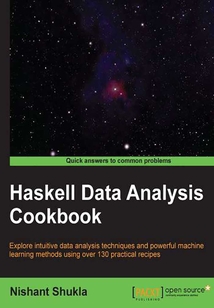舉報(bào) 

會員
Haskell Data Analysis Cookbook
最新章節(jié):
Index
Step-by-steprecipesfilledwithpracticalcodesamplesandengagingexamplesdemonstrateHaskellinpractice,andthentheconceptsbehindthecode.ThisbookshowsfunctionaldevelopersandanalystshowtoleveragetheirexistingknowledgeofHaskellspecificallyforhigh-qualitydataanalysis.Agoodunderstandingofdatasetsandfunctionalprogrammingisassumed.
目錄(174章)
倒序
- 封面
- 版權(quán)頁
- Credits
- About the Author
- About the Reviewers
- www.PacktPub.com
- Support files eBooks discount offers and more
- Preface
- What this book covers
- What you need for this book
- Who this book is for
- Conventions
- Reader feedback
- Customer support
- Chapter 1. The Hunt for Data
- Introduction
- Harnessing data from various sources
- Accumulating text data from a file path
- Catching I/O code faults
- Keeping and representing data from a CSV file
- Examining a JSON file with the aeson package
- Reading an XML file using the HXT package
- Capturing table rows from an HTML page
- Understanding how to perform HTTP GET requests
- Learning how to perform HTTP POST requests
- Traversing online directories for data
- Using MongoDB queries in Haskell
- Reading from a remote MongoDB server
- Exploring data from a SQLite database
- Chapter 2. Integrity and Inspection
- Introduction
- Trimming excess whitespace
- Ignoring punctuation and specific characters
- Coping with unexpected or missing input
- Validating records by matching regular expressions
- Lexing and parsing an e-mail address
- Deduplication of nonconflicting data items
- Deduplication of conflicting data items
- Implementing a frequency table using Data.List
- Implementing a frequency table using Data.MultiSet
- Computing the Manhattan distance
- Computing the Euclidean distance
- Comparing scaled data using the Pearson correlation coefficient
- Comparing sparse data using cosine similarity
- Chapter 3. The Science of Words
- Introduction
- Displaying a number in another base
- Reading a number from another base
- Searching for a substring using Data.ByteString
- Searching a string using the Boyer-Moore-Horspool algorithm
- Searching a string using the Rabin-Karp algorithm
- Splitting a string on lines words or arbitrary tokens
- Finding the longest common subsequence
- Computing a phonetic code
- Computing the edit distance
- Computing the Jaro-Winkler distance between two strings
- Finding strings within one-edit distance
- Fixing spelling mistakes
- Chapter 4. Data Hashing
- Introduction
- Hashing a primitive data type
- Hashing a custom data type
- Running popular cryptographic hash functions
- Running a cryptographic checksum on a file
- Performing fast comparisons between data types
- Using a high-performance hash table
- Using Google's CityHash hash functions for strings
- Computing a Geohash for location coordinates
- Using a bloom filter to remove unique items
- Running MurmurHash a simple but speedy hashing algorithm
- Measuring image similarity with perceptual hashes
- Chapter 5. The Dance with Trees
- Introduction
- Defining a binary tree data type
- Defining a rose tree (multiway tree) data type
- Traversing a tree depth-first
- Traversing a tree breadth-first
- Implementing a Foldable instance for a tree
- Calculating the height of a tree
- Implementing a binary search tree data structure
- Verifying the order property of a binary search tree
- Using a self-balancing tree
- Implementing a min-heap data structure
- Encoding a string using a Huffman tree
- Decoding a Huffman code
- Chapter 6. Graph Fundamentals
- Introduction
- Representing a graph from a list of edges
- Representing a graph from an adjacency list
- Conducting a topological sort on a graph
- Traversing a graph depth-first
- Traversing a graph breadth-first
- Visualizing a graph using Graphviz
- Using Directed Acyclic Word Graphs
- Working with hexagonal and square grid networks
- Finding maximal cliques in a graph
- Determining whether any two graphs are isomorphic
- Chapter 7. Statistics and Analysis
- Introduction
- Calculating a moving average
- Calculating a moving median
- Approximating a linear regression
- Approximating a quadratic regression
- Obtaining the covariance matrix from samples
- Finding all unique pairings in a list
- Using the Pearson correlation coefficient
- Evaluating a Bayesian network
- Creating a data structure for playing cards
- Using a Markov chain to generate text
- Creating n-grams from a list
- Creating a neural network perceptron
- Chapter 8. Clustering and Classification
- Introduction
- Implementing the k-means clustering algorithm
- Implementing hierarchical clustering
- Using a hierarchical clustering library
- Finding the number of clusters
- Clustering words by their lexemes
- Classifying the parts of speech of words
- Identifying key words in a corpus of text
- Training a parts-of-speech tagger
- Implementing a decision tree classifier
- Implementing a k-Nearest Neighbors classifier
- Visualizing points using Graphics.EasyPlot
- Chapter 9. Parallel and Concurrent Design
- Introduction
- Using the Haskell Runtime System options
- Evaluating a procedure in parallel
- Controlling parallel algorithms in sequence
- Forking I/O actions for concurrency
- Communicating with a forked I/O action
- Killing forked threads
- Parallelizing pure functions using the Par monad
- Mapping over a list in parallel
- Accessing tuple elements in parallel
- Implementing MapReduce to count word frequencies
- Manipulating images in parallel using Repa
- Benchmarking runtime performance in Haskell
- Using the criterion package to measure performance
- Benchmarking runtime performance in the terminal
- Chapter 10. Real-time Data
- Introduction
- Streaming Twitter for real-time sentiment analysis
- Reading IRC chat room messages
- Responding to IRC messages
- Polling a web server for latest updates
- Detecting real-time file directory changes
- Communicating in real time through sockets
- Detecting faces and eyes through a camera stream
- Streaming camera frames for template matching
- Chapter 11. Visualizing Data
- Introduction
- Plotting a line chart using Google's Chart API
- Plotting a pie chart using Google's Chart API
- Plotting bar graphs using Google's Chart API
- Displaying a line graph using gnuplot
- Displaying a scatter plot of two-dimensional points
- Interacting with points in a three-dimensional space
- Visualizing a graph network
- Customizing the looks of a graph network diagram
- Rendering a bar graph in JavaScript using D3.js
- Rendering a scatter plot in JavaScript using D3.js
- Diagramming a path from a list of vectors
- Chapter 12. Exporting and Presenting
- Introduction
- Exporting data to a CSV file
- Exporting data as JSON
- Using SQLite to store data
- Saving data to a MongoDB database
- Presenting results in an HTML web page
- Creating a LaTeX table to display results
- Personalizing messages using a text template
- Exporting matrix values to a file
- Index 更新時(shí)間:2021-12-08 12:44:09
推薦閱讀
- Vue 3移動Web開發(fā)與性能調(diào)優(yōu)實(shí)戰(zhàn)
- 極簡算法史:從數(shù)學(xué)到機(jī)器的故事
- Neo4j Essentials
- Apache Spark Graph Processing
- 從Excel到Python:用Python輕松處理Excel數(shù)據(jù)(第2版)
- Working with Odoo
- MATLAB for Machine Learning
- Windows內(nèi)核編程
- Learning Apache Karaf
- Julia 1.0 Programming Complete Reference Guide
- Clean Code in C#
- 軟件測試綜合技術(shù)
- RESTful Web API Design with Node.js
- 劍指大數(shù)據(jù):企業(yè)級電商數(shù)據(jù)倉庫項(xiàng)目實(shí)戰(zhàn)(精華版)
- 大象:Thinking in UML(第二版)
- RPA開發(fā):UiPath入門與實(shí)戰(zhàn)
- Go Programming Blueprints
- Python程序設(shè)計(jì)教程
- μC/OS-III源碼分析筆記
- AngularJS Deployment Essentials
- Vue.js 3移動應(yīng)用開發(fā)實(shí)戰(zhàn)
- Learning AirWatch
- OCA Oracle Database 11g:SQL Fundamentals I:A Real World Certification Guide
- 電子系統(tǒng)設(shè)計(jì)基礎(chǔ)
- C#程序設(shè)計(jì)經(jīng)典300例
- DevOps和自動化運(yùn)維實(shí)踐
- 數(shù)據(jù)庫管理與開發(fā)項(xiàng)目教程:MySQL(微課版·第4版)
- Java寶典
- Mastering The Faster Web with PHP,MySQL,and JavaScript
- Practical Real-time Data Processing and Analytics

